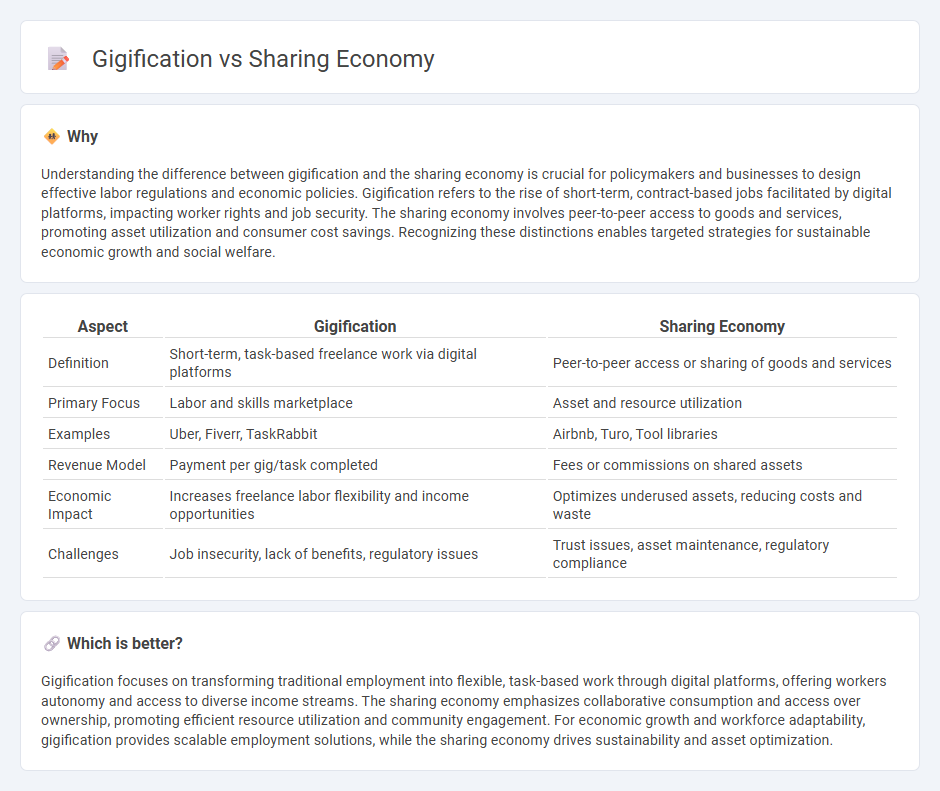
Gigification transforms traditional employment by enabling freelance and short-term contracts through digital platforms, while the sharing economy focuses on peer-to-peer access to goods and services, maximizing resource utilization. Both models disrupt conventional market structures but differ in their approach to ownership and labor. Explore how these economic trends reshape industries and consumer behavior.
Why it is important
Understanding the difference between gigification and the sharing economy is crucial for policymakers and businesses to design effective labor regulations and economic policies. Gigification refers to the rise of short-term, contract-based jobs facilitated by digital platforms, impacting worker rights and job security. The sharing economy involves peer-to-peer access to goods and services, promoting asset utilization and consumer cost savings. Recognizing these distinctions enables targeted strategies for sustainable economic growth and social welfare.
Comparison Table
| Aspect | Gigification | Sharing Economy |
|---|---|---|
| Definition | Short-term, task-based freelance work via digital platforms | Peer-to-peer access or sharing of goods and services |
| Primary Focus | Labor and skills marketplace | Asset and resource utilization |
| Examples | Uber, Fiverr, TaskRabbit | Airbnb, Turo, Tool libraries |
| Revenue Model | Payment per gig/task completed | Fees or commissions on shared assets |
| Economic Impact | Increases freelance labor flexibility and income opportunities | Optimizes underused assets, reducing costs and waste |
| Challenges | Job insecurity, lack of benefits, regulatory issues | Trust issues, asset maintenance, regulatory compliance |
Which is better?
Gigification focuses on transforming traditional employment into flexible, task-based work through digital platforms, offering workers autonomy and access to diverse income streams. The sharing economy emphasizes collaborative consumption and access over ownership, promoting efficient resource utilization and community engagement. For economic growth and workforce adaptability, gigification provides scalable employment solutions, while the sharing economy drives sustainability and asset optimization.
Connection
Gigification drives the growth of the sharing economy by enabling individuals to monetize underutilized assets and skills through digital platforms. This creates flexible work opportunities and promotes peer-to-peer exchanges, reducing reliance on traditional employment and ownership models. The synergy between gigification and the sharing economy fuels economic decentralization and consumer empowerment.
Key Terms
Peer-to-Peer (P2P) Platforms
Peer-to-peer (P2P) platforms drive the sharing economy by enabling individuals to share assets or services directly, emphasizing collaborative consumption and resource efficiency. Gigification transforms these platforms into flexible labor markets, where independent workers offer on-demand services, often mediated by digital apps with dynamic pricing models. Explore how P2P platforms shape modern economic trends and impact work ecosystems.
Independent Contractors
Independent contractors in the sharing economy benefit from flexible work arrangements and access to digital platforms that connect supply and demand efficiently. Gigification transforms these freelance roles into short-term, task-based gigs, emphasizing rapid task completion over long-term engagement. Explore how these trends impact labor rights and economic opportunities for independent workers.
Access over Ownership
The sharing economy emphasizes access to goods and services without the need for ownership, fostering collaboration and maximizing resource utilization across platforms like Airbnb and Uber. Gigification transforms traditional jobs into flexible, task-based work, often facilitated by digital marketplaces, but focuses more on labor dynamics than access to assets. Explore the distinct impacts of sharing economy and gigification on modern consumption and employment trends to understand their evolving roles.
Source and External Links
What Is the Sharing Economy - Example Companies, Definition ... - The sharing economy is a flexible network that allows people to exchange tangible and intangible assets directly, increasing efficiency by enabling resource sharing on demand without owning items like cars, leveraging technology and the internet to connect providers and customers at scale.
Sharing Economy - Definition, Model, Pros and Cons - The sharing economy is an economic model where individuals and groups collaboratively share goods and resources, transforming physical assets into services, facilitated by advancements in big data and online platforms that allow owners to monetize underused assets.
Sharing economy - Wikipedia - The sharing economy is a socio-economic system in which consumers share in the creation, distribution, and consumption of goods and services, offering benefits like increased access without ownership, improved service quality, community strengthening, and flexible economic opportunities.
 dowidth.com
dowidth.com